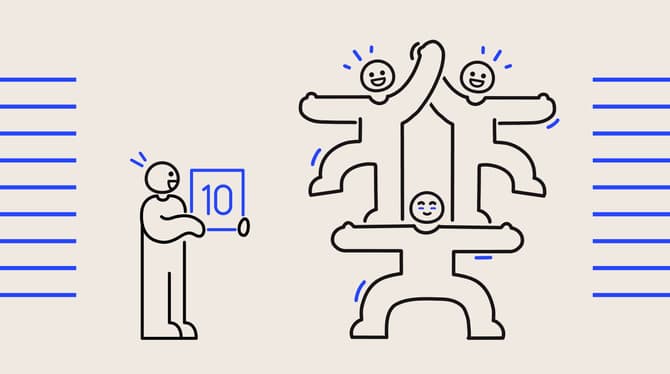Whether you are giving or receiving them, annual performance reviews can be stressful. Employees often feel nervous about the constructive criticism they might get, while their managers worry about treating every team member fairly and giving appropriate feedback.
A performance review meeting doesn’t have to feel so fraught, though. When managers and employees approach them with the right mindset and proper preparation, these conversations can build employee confidence and strengthen manager-employee relationships.
Exclusive online summit
·
May 23 2024
Moments that matter: how to seed great work
Handle your performance review meetings with confidence
What is a performance review meeting?
Performance reviews are a two-way conversation between a manager and an employee, and a key part of employee development and growth. They’re a chance to assess an employee’s performance, highlight their progress, and celebrate all the ways they make your team (and your organization) better.
Traditional performance reviews were (and in some cases still are) conducted annually with a focus on evaluating an employee's performance over the span of the year. However, modern performance reviews are now more typically (and effectively!) conducted quarterly or monthly, with a focus on how to improve future performance.
For example: During a performance review, you might commend your introverted employee for the steps they’ve taken to become more engaged with the team and discuss which of those steps have been the most effective.
Why is it important to have frequent performance reviews?
Because performance reviews give employees clear benchmarks on their progress, you want to have them on a regular basis. Ideally, you’ll have a performance evaluation every three to six months. Why?
- Frequency reduces any stress around the process. The more often you host performance reviews, the better acquainted everyone will be with the process, and the less intimidating they’ll be.
- Performance reviews are part of a broader employee performance development strategy. These meetings go alongside one-on-ones, goal setting meetings, feedback sessions, and employee engagement discussions to help you keep up with how people are progressing.
- An employee performance review is an opportunity to celebrate your team member. If you're in need of some inspiration on how to tell someone they're doing a great job, check out some examples of employee recognition messages.
- Performance reviews open the door for growth and salary conversations. Performance reviews are often a time to discuss salary, roles, and potential promotions, which can add to the stress of them. Having them more often means lightening the weight of these discussions and creating more opportunities to have them, rather than looking at the coming year as a whole.
Out with the old: Why should annual reviews be a thing of the past? Because with too much recency bias, an annual review is no longer a responsible or effective way to evaluate. It's overly ambitious to think that managers can collect accurate, year-long notes on each of their employee's performance. It can also be demotivating for employees. The review period matters.
Performance review meeting tips for success
These helpful tips will help you have the best performance review meetings possible, so you and your team members leave on the same page.
1. Make sure you're prepared and understand the process…
As a manager, having a clear process makes sure that you cover everything that needs to be discussed in your meeting. It removes the potential for any surprises in how the conversation will unfold, and allows both you and your employee to properly prepare for the review ahead of time. It's a great idea to compile some specific examples and data to back up your points with each person.
If your employee is unsure about how the process works, feel free to walk them through it to help make them more comfortable. We'll elaborate more on this in tip #3.
2. …and use the same process for all employees
It’s important to keep the performance review process uniform for every person on your team. This will help you be clear in every evaluation because you have a standardized structure. Plus, consistency is the best way to treat everyone fairly, which will inspire trust — both in you and the process.
Before setting it in stone, just be sure that your framework can be applied to every member of your team and account for different competencies. You shouldn’t need a separate performance review process for a graphic designer, a content marketer, or administrative assistant. You want to be able to apply your process to all types of employees, regardless of what or how they contribute to the team.
If a process doesn’t currently exist, you’ll want to find a performance review framework that works for you. This way, you'll have a clear agenda template to use for your meeting.
3. Manage expectations
As we touched on in tip #1, just because you understand the performance review process, it doesn’t necessarily mean your employees understand it. If you don’t explain it to them ahead of time, they might feel overwhelmed, unprepared, upset, or even blindsided.
Prior to a performance review, make sure you:
- Take the time to explain the process to your team, and walk your employees through what you’re going to discuss during the meeting.
- Let employees know what they should come prepared with, whether it’s a self-evaluation, talking points, questions, notes, or examples.
- Give everyone the opportunity to ask any questions about the process, in a group setting or one-on-one.
4. Come prepared
Just like you would show up to an important one-on-one meeting prepared with talking points and relevant meeting questions, you also want to show up to your performance review prepared with notes, data, and specific examples that speak to your employee’s performance.
Why? Because notes, data, and examples will elevate the conversation. You’re not just giving your opinion — you’re sharing facts.
Need help with note taking during employee performance conversations and goal-setting discussions? Officevibe's one-on-one software keeps track of all your meeting notes in one place, so planning reviews is a breeze.
5. Connect with your peers
Syncing with other managers at your company helps create consistency within the organization. And reaching out to your network outside of your company can bring a new perspective on how other people do performance reviews.
If you're a new manager or haven't done a performance review at your company yet, connecting with an HR rep is a great place to start. Oftentimes, Human Resources departments will have pre-set processes and tools to help managers navigate through tasks like performance reviews.
6. Make every review a two-way conversation
You want to have an agenda when you walk into a performance review meeting. But performance reviews aren't just an opportunity to talk at your employee for an hour straight. To be effective and productive for both parties, a performance review needs to be a two-way conversation.
Once you’re done sharing with your employee what, in your view, they’re doing well and where you see opportunities for improvement, give them the opportunity to share their perspective. This can help you both get a broader view of the employees’ performance, and ensure you both walk away feeling heard and understood.
7. Clearly define performance appraisal criteria
To clearly communicate with employees during performance review meetings, managers should have a clear understanding of what constitutes good or poor performance, and how to explain it. Easy-to-understand performance criteria can help managers and employees define success, measure impact, assess performance plans, and decide what steps to take next.
While gathering information and data is important, managers should also be mindful about approaching performance reviews with a coaching mindset. If they can highlight and distill information clearly, it makes it easier for their employees to understand and absorb the feedback they receive.
8. Provide support and build trust
While business is business, we're all human at the end of the day. That's why the approach and delivery should focus more on what employees are doing well, rather than dwelling on their weaknesses or negative behaviors.
That said, constructive criticism is key. See it as a way to correct the course if needed and uncover opportunities for improvement. Work on building trust by guiding employees in the right direction. Help them evolve and grow confidence by reinforcing their strengths. When employees feel supported by their managers, they'll be more receptive to the performance feedback they've been given, and more likely to reflect on their own performance in an objective way.
⭐️ Learn how to motivate (not stagnate) your teams with our complete guide on performance management and employee development.
9. Ask effective questions
Perhaps one of the most important tips of all is to make sure you are asking the right performance review questions. The right questions help keep both you and your employee focused on each individual's success, as well as the success of the company. The feedback you gather from asking these questions is imperative in helping you manage expectations, set a clear path for growth, identify areas of improvement, and define short and long-term goals.
Here are some examples of questions you can ask during feedback meetings with your employees:
- What recent accomplishments are you most proud of?
- What goals do you have set for the next quarter?
- Do you have obstacles standing in your way?
- As your manager, how can I improve?
Always remember that this is a conversation between two people. Encourage your employees to ask you questions in return. Open the floor to discussion during these meetings, whether it be about learning from past performance or achieving goals in the year ahead. Talk about how you can help guide and support them, and touch on any point they feel comfortable addressing during the conversation.
10. Define actions and next steps
Once you've had your performance review meeting and shared your feedback, both the manager and the employee should leave with a to-do list of actionable items that they can then later follow up on. Long or short, the list serves as a valuable action plan that should feel achievable by both parties.
Next time you check in on your employee's performance, you can review the past list together before setting new action items for the next quarter, or even the year ahead.
Walk into your next performance review with confidence
Performance reviews can be stressful — but they don’t have to be! And now that you know how to manage the performance review process, you have everything you need to walk into future performance review periods and conduct them with confidence. In turn, you’ll inspire that same confidence from your team.
Performance management and open discussion are made even easier with one-on-one tools like Officevibe. See how it can help you get the most out of your next performance reviews.



